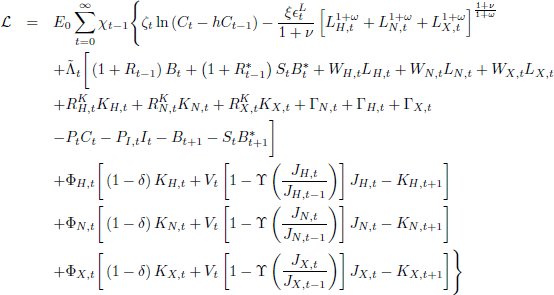RDP 2015-11: Unprecedented Changes in the Terms of Trade: Online Appendix 2 Derivation of Equilibrium Conditions
August 2015
2.1 Households
The household's problem is to choose a sequence for Ct,
LH,t, LN,t, LX,t,
Ih,t,
IN,t, IX,t, KH,t+1,
KN,t+1, KX,t+1,
Bt+1,  to maximise expected
lifetime utility subject to the budget constraint and capital accumulation
equation. The Lagrangian for this problem is:
to maximise expected
lifetime utility subject to the budget constraint and capital accumulation
equation. The Lagrangian for this problem is:
The first order conditions for the household's problem are:
and
where  is the discount factor on nominal claims and
Qj,t = Φt/Λt
is Tobin's Q for sector j.
is the discount factor on nominal claims and
Qj,t = Φt/Λt
is Tobin's Q for sector j.
Demand for each type of consumption good:
and for investment goods:
2.2 Firms
2.2.1 Commodity Firms
Given prices, commodity firms choose LX,t and KX,t to maximise profits, given by:
The resulting quantities are:
Note that this implies that Γx,t = 0.
2.2.2 Tradeable Firms
Profits for tradeable firms are given by:
The optimality conditions of the cost minimisation problem are:
where MCt denotes real marginal cost.
When setting prices, the problem of firm i is to choose PH,t(i) to maximise:
subject to the demand constraint that: YH,t(i) =  YH,t.
Optimal price setting implies that:
YH,t.
Optimal price setting implies that:
2.2.3 Non-tradeable Firms
Profits for non-tradeable firms are given by:
The optimality conditions of the cost minimisation problem are:
where MCN,t denotes real marginal cost.
The firm's pricing problem is to choose PN,t(i) to maximise:
Optimal price setting implies that the inflation rate of non-tradeable goods is given by:
2.3 Importing Firms
Profits for importing firms are given by
Optimal price setting implies that the inflation rate of imported goods is given by:



































